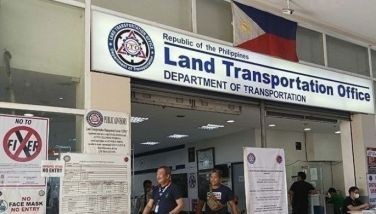Save Laguna de Bay

Laguna de Bay is the largest lake in the Philippines and third largest freshwater lake in Southeast Asia. It is surrounded by the provinces of Laguna and Rizal, and also Metro Manila (Pasig, Taguig and Muntinlupa). It is around 76,000 hectares and has a volume of 3.2 billion cubic meters. The lake is an important source for fishing, for irrigation and for domestic water needs; it is also a temporary reservoir. It is used as a transport route but still can be further developed.
The lake used to be bluish green but in the recent decades it has become muddy brown. If Boracay can be saved in a jiffy, I don’t see why Laguna de Bay can’t be saved as well. Efforts have been made but seem to be too slow. The lake is dying. Urbanization, industrial development and deforestation of its watershed have extremely stressed the ecosystem which urgently needs rehabilitation.
Last year, Maricar Cinco, a news correspondent wrote about pollution, squatting, and industries as major factors that hasten the death of Laguna de Bay. In her report she cited how the water of Laguna de Bay in the 1980s was good for swimming and fishing. Today, Laguna de Bay has become a public hazard.
According to the report, in 2009, Typhoon “Ondoy” left Laguna de Bay filled to the brim, with the water level rising to 13.9 meters (the normal being 10 meters). This left the towns and cities in the provinces of Laguna, Rizal and Metro Manila flooded for months.
What did the government do? Then President Gloria Macapagal Arroyo made the rehabilitation of Laguna de Bay a “presidential priority.” Toward the end of her term, she entered into a P18.5 billion lake rehabilitation project with a Belgian company, Baggerwerken Decloedt en Zoon. The project was supposed to cover the dredging of the 7-kilometer Napindan Channel, which is the lake’s only outlet to Manila Bay, dredging of a 70-km nautical channel, construction of 12 ferry stations, and rehabilitation of wetlands around the lake.
Unfortunately, when P-Noy became president in 2010, he ordered the deal to be dropped. The Palace said that in a matter of three years, the areas to be dredged will end up silted again because of heavy deforestation and soil erosion. The Aquino administration instead announced in 2014 the supposedly biggest public-private partnership which was the P122.8 billion Laguna Lakeshore Expressway Dike Project. It was reported that the dike will not only serve flood mitigation purposes but also create a 47-km expressway between Taguig City and Los Baños and reclaim about 700 hectares of land around the lake.
Sadly, the bidding for the project failed when the pre-qualified bidders – Trident Infrastructure and Development Corp. (composed of Ayala Land Inc., Megaworld Corp., Aboitiz Equity Ventures Inc. and SM Prime Holdings Inc.), and San Miguel Holdings Corp. and Alloy Pavi Hanshin LLEDP Consortium backed out. As a result, not one flood control structure was built. Susmariosep!
In 2014, Architect and Urban Planner Felino A. Palafox Jr. wrote about his vision of Laguna de Bay, “The lake is located along Metro Manila, Laguna and Rizal provinces, parts of Batangas, Cavite and Quezon…Laguna Lake is the main source of water, fish, aquaculture, agriculture food commodities, and industrial raw materials and manufactured goods. Furthermore, according to the 2005 census of NSO, the lake has a watershed population of 13.2 million.
Immortalized in the artwork of Amorsolo and in the poetry of Jose Rizal, the Laguna de Bay and its surrounding environs claim an important position in our nation’s collective memory. However, its beauty and significance to the Filipinos are not simply a thing of the past; indeed Laguna de Bay is a living lake which continues to nourish this nation, providing water for us to drink as well as much food to our tables.
Storms, typhoons, rains, floodwaters, mud, silt, pollution, deforestation, illegal logging in uplands, abuse of the lake, and the rapid urban expansion, generally growing outwards from the Metro Manila area towards the Laguna Lake region greatly affect Laguna de Bay and its environs. The Calabarzon sub-region (the area which the lake occupies) now houses 15 percent of the nation’s population as it has become the catch basin to Metro Manila’s population and urbanization over-spill. The possible consequences of this rapid swelling of population include a food and water shortage, the increase of traffic congestion and environmental degradation.
Despite rapid urbanization and suburbanization, Laguna de Bay still flourishes as a center for agricultural and aquacultural activities. These activities include the growing of rice, animal husbandry, duck-raising, fishing and fish farming. Laguna de Bay has a production capacity of Manila’s freshwater fish. Further pollution of the lake poses a major threat to this significant food supply.
Another resource threatened by continued pollution is the water itself. This is perhaps one of the most critical issues facing our nation, as it is quite simple to understand that water is the lifeblood of any human settlement…
Laguna de Bay serves as perhaps the single most important potential future source of potable water for the Manila Bay Metropolitan Region and Calabarzon.
Because of its strategic location, the lake has many water transport potentials. The most accessible and most commonly used thoroughfare is the South Luzon Expressway (SLE). Traffic is bottlenecked at SLE, though this serves as the main route for vehicles going to and from the South, Calabarzon to Metro Manila…”
Early this year, Laguna Lake Development Authority (LLDA) General Manager Jaime “Joey” Medina met with Adrian Kiss of the Hungarian Water Technology Corporation (HWTC) to discuss the development projects for Laguna de Bay. This meeting was a follow-up to the working visit to Hungary of DA Secretary Manny Piñol and LLDA GM Medina in September last year, where the Laguna Lake rehabilitation program was proposed as a government-to-government engagement to tap the Hungarian expertise. This project would again address the issue of pollution and wastewater treatment in Laguna Lake. By the way, Hungary is known as a world leader in water services and wastewater treatment technology. Let’s see what comes out of this!
In his first State of the Nation Address, President Duterte said he wanted issues on watershed destruction, land conversion and pollution in Laguna de Bay stopped. What is the DENR doing? Hasn’t it been a year since the clearing operation of Laguna de Bay started? Why are there still many fish pens around?
Wake up DENR! Get your act together. Don’t be fooled by your own directors and officers. Action turned into environmental improvements will always speak louder than words.
- Latest
- Trending





























